WHEN THE ANCIENT EGYPTIANS SOARED
Friday, May 18 2007 @ 02:22 PM CDT Views: 492

By Ahmed Maged
Ancient Egyptians must have been familiar with aviation. They could manufacture types of airplanes to get aerial views of some important locations in Egypt; a technology that helped them secure their builders lots of essential materials, opined an Egyptologist Basam Al Shammaa.
Al Shammaa, who has a special interest in the subject, pointed out that centuries before the science of geography came into existence, a papyrus map showing the locations of copper and gold mines in some mountainous areas could prove that the ancient engineers must have invented sail-propelled planes to explore the mountains and deserts.
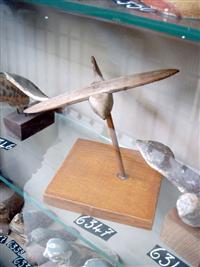
Al Shammaa noted: "It's only one map that for some might offer little evidence, but only 30 percent of secrets related to ancient Egypt have been revealed. There may be a lot more in store. So we shouldn't rule out the possibility that future discoveries will reveal more about ancient Egyptians and aviation."
The map, which is currently exhibited at the Egyptian Museum in Turin, the second biggest Egyptian museum in the world, dates back to King Ramses VI's era. It shows the gold mines in an area known as Fawagir.
The map couldn't have been drawn without getting a panoramic view from a flying object and to the best of his belief this was a plane, stressed the Egyptologist.
The link between aviation and ancient Egyptians first occurred to Al Shammaa as he came across a wooden statue of Horus, the falcon god, currently being exhibited in a room located close to the hall containing King Tutankhamen's treasures at the Egyptian Museum.
Al Shammaa continued: "This is a small statue that's displayed as part of a big collection in a glass showcase. Overshadowed by the treasures of King Tut, no one has really taken notice of this collection."
Al Shammaa explained: "But there are many reasons to make me believe that this was a model of a sailing plane rather than an image of Horus the falcon-god.
"First this wooden statue is made up of two interlocked parts, which is not in line with the ancient Egyptian tradition of sculpting the statue out of one mass of material. Second, unlike other statues of Horus produced by the ancient Egyptian sculptors, this is one wherein you find the wings fluttering to denote that the bird was in flying mode."
He added: "Other statues depicted Horus, the falcon god, with folded wings and usually the feathers were accentuated with black or a range of other colors. But none of these features could be seen in this model, all of which should raise the likelihood that this was in the shape of a plane.
"The bird's head is pointed with a spoiler under its neck that resembles those of today's airplanes designed to push back the air and propel the plane's body.
"The tail isn't parallel to the ground; it's erect and rather perpendicular to the soil, vertical not horizontal, a tail shape that doesn't match that of a falcon."
The fact that ancient Egyptians were familiar with aviation should not come as a surprise, as there are lots of other indications that support the assumption that flying must have been part of their religion and technology, Al Shammaa remarked.
"Besides the fact that the ancient geographers were the first to draw a virtual map, their mythology attests to the sanctity of birds and their association with Horus, the falcon god.
"His name in hieroglyphics was Hir, which later became Horus. The bird was the first to be worshipped by people. It was synonymous with the king. When the king died, worshippers used to say: 'Hir has risen.'"
According to Al Shammaa, when interred, the dead were thought to have been resurrected in the shape of a bird. That bird flew through the labyrinths of the Afterlife until it reached the seat of Anubis, god of the other world.
Al Shammaa believes that these findings should offer researchers clues to the important subject of ancient Egyptians and aviation.
"More discoveries are bound to reveal the entire truth."
Daily Star Egypt
http://www.coptsunited.com
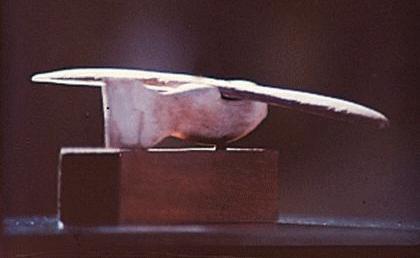
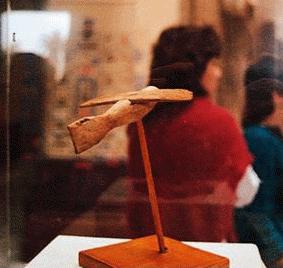




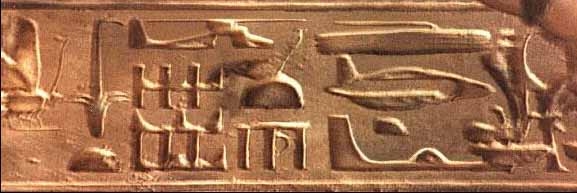
In 1898 archeologists found a small wooden object in a tomb at Saqqara, Egypt. They identified it as a "bird model" and placed it in a box of other bird figures in the storage area of a Cairo museum. The object was forgotten for many years until Dr. Khalil Messiha rediscovered it and realized its significance. The Egyptian Ministry of Culture comissioned a group of scientists to study the object. As a result the object was given its own exhibit detailing its unusual features. The six inch long artifact is not a bird effigy, but an advanced model glider. The wings curve downward at the tips, a form called reversedihedral by modern aircraft designers. The object has proportions which would allow a full scale version to stay in flight at extremely low speeds, down to 45 miles per hour, while at the same time carrying an enormous payload.
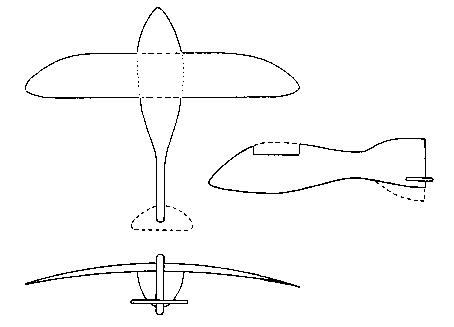
Ancient Egyptian engineers always built small scale models of their projects, from ships to temples. Is this artifact an echo of lost technology from before a worldwide cataclysm?
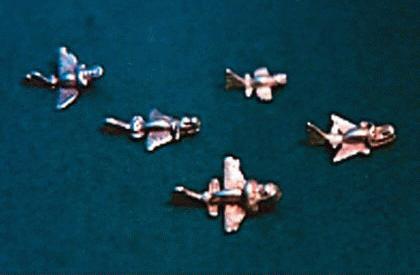
http://zomb.tripod.com
***************
Precolombian Airplane Models
Is the concept of an airplane limited to Egypt? That doesn't seem to be the case. Gold trinkets were found in an area covering Central America and coastal areas of South America, estimated to belong to a period between 500 and 800 CE, but since they are made from gold, accurate dating is impossible and based essentially on stratigraphy which may be deceptive. However, we can safely say that these gold objects are more than 1000 years old.
As seen from the pictures, the shape of the sample object is rather ambiguous. The archaeologists labelled these objects as zoomorphic, meaning, animal shaped objects. The question is, what animal do they represent? When we compare these with other objects from the same cultures depicting animals, a curious facet of the comparison would be obvious: the other objects are recognizable, rendered usually with a great accuracy and attention to realistic detail.

Whatever this object is supposed to be or represent, its remarkable resemblance to a modern aircraft or spacecraft is uncanny.

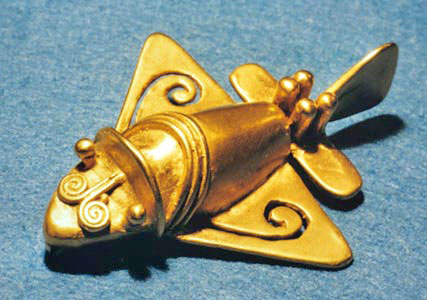
There are several types of animals which fly—birds, insects, and several mammals, such as bats and some gliders, for instance flying squirrels, opossums, and then there are some lizards; there are also some fish which for brief periods glide through the air. There are water animals which seem to fly through the water, such as rays, skates and some selachians. But how does the depicted object compare with these choices? All its features taken into a consideration, we have no match. Seen fr0m above, the object obviously has no fish features, but seems to show rather explicitly mechanistic ones.
The structures just in front of the tail are strongly reminiscent of elevons (a combination of ailerons and elevators) with a slight forward curve, but they are attached to the fuselage, rather than the wings. In any case, they look more like airplane parts than like the claspers of a fish. If the two prominent spirals on the wings are supposed to be a stylized version of the eyes of a ray, then what are the two globular objects positioned on the head supposed to represent?
To complicate the identification even more, the spirals on the wings have their copies positioned on the nose of the object, in the opposite direction. When the object is viewed in profile, the did similarity to anything fr0m the animal kingdom is even more pronounced. If the zoomorphic explanation is supposed to hold, then why did the artist cut the head off almost three quarters fr0m the body? And why is the nose is practically rectangular and the cut tilted forward, with eyes positioned at either side, when fish eyes are usually more near the center of bodyline and far forward on the head?
What we can make of the semicircular grooves on the inside of the cut? What is it supposed to be—fishwise? And what about the scoop, forward and under the cut? It is a scoop, not just a ridge for drilling a hole through to place the object on a necklace chain. Then there is another rectangular feature, positioned further back at the approximate center of gravity under the fuselage.
The wings when viewed fr0m the side are perfectly horizontal, but when seen fr0m the front, they curve slightly downward. The elevators, which are right behind the wings, are positioned on a slightly higher horizontal level and are square-ended, thus a definite geometric shape. Above them is another rectangular shape, with a relief which may be reminiscent of knobs. The tail is equally intriguing. No fish has only a single, upright and perpendicular flange. But this tail fin has an exact shape of fins on modern airplanes. There are also some markings on the tail which are hard to identify, but it does not seem to be anything related to animals, either.
When all the features are taken into an account, the object does not look like a representation of any known animal at all, but does look astonishingly like an airplane. The photos and enlarged outline of the object has been submitted for an analysis to several people fr0m the field of aerodynamics. One of them was Arthur Young, a designer of Bell helicopters and other aircraft. His analysis confirmed that the object contains many features which would fit the airplane hypothesis, but there were several ones which would not fit that scenario. Wings do seem to be in the wrong place—they should be further forward so that their 1/4-chord coincides with the center of gravity. The nose is not like anything on airplanes, as well. So, while the object is suggesting an airplane, some features would not seem to support this hypothesis.
But let's entertain several possibilities. If we imagine that the separation after the windshield is not a cockpit and that the pilot and the cargo were located somewhere in the main fuselage body, then we can envision the nose as something else. Let's assume that the nose is actually a jet. If the machine needs to slow down, the jet flow directed against the path of flight would accomplish just that. But how to redirect the jet into the opposite direction?
If we envision the nose as a movable part of the plane, turning around the point located where the nose and fuselage meet, thus pivoting the nose downward to tuck it under the fuselage, that would enable the desired effect. What's more, it will re-adjust the center of gravity and the wings would be just in the right place for a high powered flight.
Another problem, though, will appear and that is the drag which would be created by the back of the nose now positioned in front. But that can be attributed to artistic license. That seems to be the case, because several other similar planes feature the back part of the nose tilted more forward, so the angle of the back of the nose when pivoted is more corresponding to aerodynamic principles.
All things considered, the object seems to represent a convertible type of craft, with two possible configurations:
one for ascent when the nose is facing backwards
the other for descent with the nose facing forward
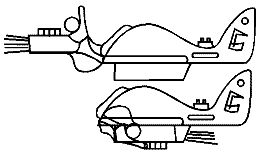
One unsolved item remains—the spirals on the both wings and the nose. According to Amerindian iconography, these spirals have discernable meaning—they represent ascending and descending, depending on whether they are right-oriented or left-oriented, respectively. As the spirals are not only on wings but also on the nose, the meaning is fairly obvious—the wings and the nose (as much) were the features which were directly involved in ascent and descent.
There are other cultures which mention flying vehicles of some sort or another. The most known of these sources are Indian epics, especially the Mahábhárata and other Védic sources as Bhágavata Purána and Rámáyana. The flying devices were called vimanas and were extensively discussed in Vaimánika Shástra, describing multitude of machines with different purposes and capabilities.
Other source of information about flying machines may be considered, such as the Bible and some apocryphal works. The Book of Ezekiel seems to be describing the close encounter of a man fr0m a non-technological culture with a device which to him must have been miraculous. We have to put ourselves into his shoes to comprehend his astonishment and the other worldness of his encounter. The limited scope of knowledge of the world around him, his primitive environment, dictated the language and conceptual framework with which he tried to capture his encounter for fellow tribesmen. For him it seemed that he encountered The God, with his suite of angels, because in his simple world, there was no other interpretation.
It is not necessary to reach for an alien type of scenario to explain the encounter; we can entertain a possibility that a remnant of an advanced civilization was still present, in a limited scope, at the time of Ezekiel. But for some, the encounter bears uncanny similarity to the modern-day encounters with UFO's. Another source of similar material is the Book of Enoch, particularly the Slavic version, which contains some parts which the Greek version is missing. The book not only describes flying in the air, but also through outer space, including the relativistic effects mentioned—Enoch spent several days on a spacecraft, but when he returned to Earth, several centuries had passed by.
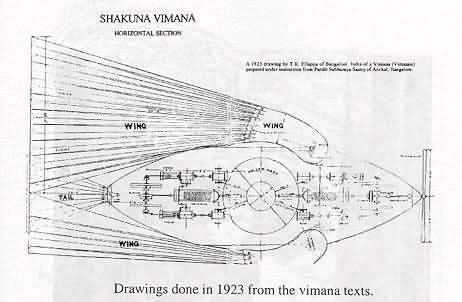
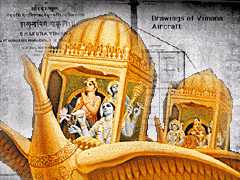
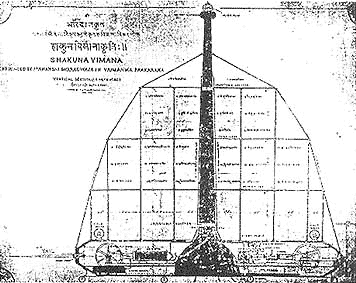
Vimanas of Ancient India
In the Vedic literature of India, there are many descriptions of flying machines that are generally called vimanas. These fall into two cate- gories: (l) manmade craft that resemble airplanes and fly with the aid of birdlike wings, and (2) unstreamlined structures that fly in a mysterious manner and are generally not made by human beings. The machines in category (l) are described mainly in medieval, secular Sanskrit works dealing with architecture, automata, military siege engines, and other mechanical contrivances. Those in category (2) are described in ancient works such as the Rg Veda, the Maha-bha-rata, the Rama-yana, and the Pura-nas, and they have many features reminis- cent of UFOs.
http://www.bibliotecapleyades.net

http://hiddenmysteries.com/xcart/product.php?productid=17281

http://hiddenmysteries.com/xcart/product.php?productid=17281

http://hiddenmysteries.com/xcart/product.php?productid=17402








What's Related